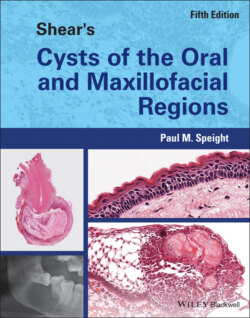Читать книгу Shear's Cysts of the Oral and Maxillofacial Regions - Paul M. Speight - Страница 32
Histopathological Examination of Cysts
ОглавлениеIn most cases the responsibility for a final diagnosis lies with the histopathologist who must examine samples of tissue. As stated above, it is important that the pathologist does not make a final diagnosis without first considering the clinical and radiological features of the lesion. These may be stated on the pathology request form, but often the pathologist should read the radiology report, consult with the radiologist, or personally examine the radiographs. Many cysts may reach a large size and it is good practice to establish a diagnosis before definitive surgery. This means that the histopathologist is often presented with a small incisional biopsy of a large lesion. In most cases, consideration of the radiological and histological features together is sufficient to establish a diagnosis. The key features summarised in Tables 2.2 and 2.3 should assist decision making in most cases. Occasionally a definitive diagnosis is not possible on a small biopsy and a final diagnosis must await examination of the whole specimen. Pathologists must not be afraid to withhold a final diagnosis until it has been possible to examine sufficient tissue.
Histopathological examination of a cyst begins with examination and sampling of the whole specimen. If an associated tooth is also removed, then the relationship of the cyst to the tooth can be directly observed and is of particular value in the diagnosis of a radicular cyst (located at the tooth apex), dentigerous cyst (attached at the cementoenamel junction; Figure 5.18), and paradental cyst (attached to the disto‐buccal aspect of the tooth; Figure 4.6). In all cases it is of value to examine the cyst in its entirety and also to dissect it and examine the cut surface and the lumen. Most cysts are unilocular with a thin regular lining, but careful examination of the gross specimen will show evidence of multilocularity and reveal areas of thickening or luminal nodules if present. Cysts that are typically multilocular on gross examination include the botryoid odontogenic cyst (Figures 8.3, 8.9, and 8.10) and glandular odontogenic cyst (Figure 10.6). Thickening of the wall or luminal nodules are seen in lateral periodontal cyst (Figure 8.6), glandular odontogenic cyst (Figures 10.6 and 10.8), and calcifying odontogenic cyst (Figures 11.8 and 11.9). Calcifying odontogenic cyst may also have calcified material in the wall or be associated with an odontoma. Representative samples of the cyst wall, including any areas of thickening, should be taken for histological examination and any hard tissue should be decalcified and sampled for histology.
On dissection, most cysts contain small amounts of serosanguinous fluid, but the odontogenic keratocyst and orthokeratinised odontogenic cyst usually contain a ‘cheesy’ or ‘buttery’ keratinaceous material that is cream or yellow coloured, and may have a characteristically unpleasant odour. Such contents will be familiar to many pathologists as a characteristic feature of epidermal cysts of the skin.
The histological features of each cyst and the histological differential diagnosis are described in detail in each chapter. Very few cysts have histological features that are absolutely diagnostic or pathognomonic, and diagnosis is usually made by considering a combination of features in the context of the radiology. The only possible exception to this is the odontogenic keratocyst, which shows a thin regular lining of parakeratinised epithelium with features that are unique to this cyst type (see Figures 7.15–7.17). Table 2.3 provides an overview of characteristic histological features and their diagnostic utility for different cyst types.
